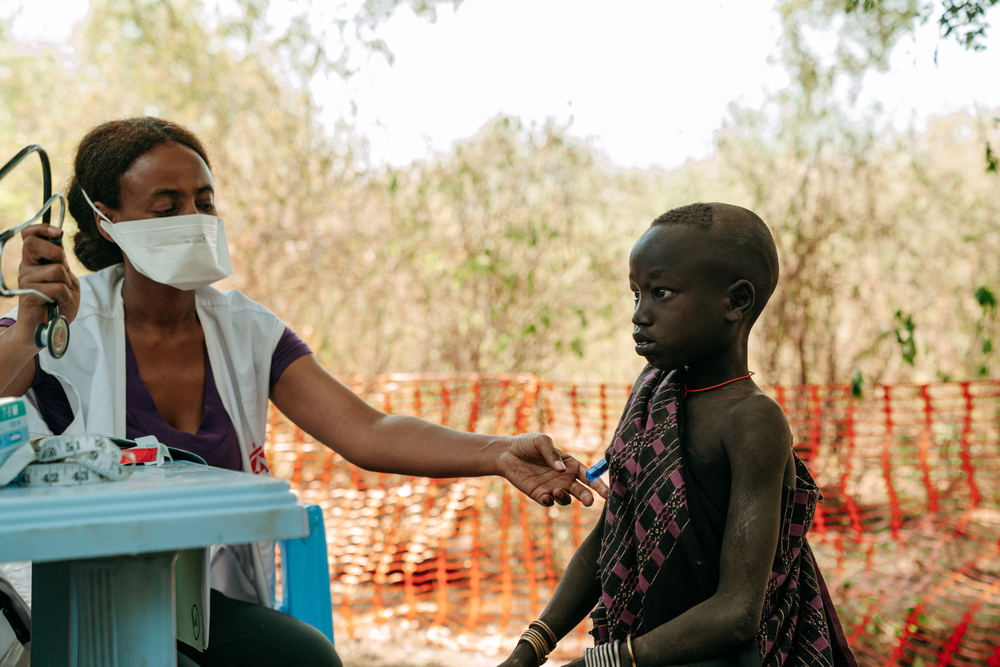Emergency alert
In late 2022, MSF’s team in Southern Nations, Nationalities and People’s Region (SNNPR) of Ethiopia received an alert about an usually high number of deaths in the south Omo Valley among an isolated group of people from the Mursi Tribe, living in what is now a national park. The Mursi are a small tribe of approximately 7000 people, among more than a dozen isolated indigenous groups in Ethiopia’s Lower Omo Valley – largely pastoralists, hunter gatherers, and flood-retreat cultivators. Visceral leishmaniasis, also known as kala azar, was affecting many among the Mursi and other indigenous peoples in the area.
“Patients come with a huge swelling of their spleen and liver, with fever and also malnutrition and sometimes even bleeding because their bone marrow is affected. It's also among the neglected tropical diseases that can cause a 95% fatality [rate] if not treated. So you can understand the urgency of finding these cases and putting them on treatment,” said MSF doctor, Hewot Melak.
Since then MSF teams have been responding to this acutely neglected emergency situation - actively finding and treating 79 patients with visceral leishmaniasis in less than two months.
Worse than expected
After receiving the alert, an MSF team travelled to the South Omo Valley. What the team found was shocking: an alarmingly high number of kala azar cases amongst this relatively small population with no access to health care at all. The MSF assessment team also found a high number of people suffering from severe acute malnutrition caused by kala azar – both children and adults.
“We don’t know where it comes from but it kills a lot of people,” Bicolshe, a community member later told MSF. Another patient, an elderly man named Samakaoulu Kumuhuli Data, shared that he had lost two wives and five children because of the disease.
Kala azar is not only one of the most neglected tropical diseases, but also one of deadliest. It is almost always fatal if untreated and has spread to become endemic in many parts of Ethiopia, after first being documented in 1942. More than 3,2 million people across the country are at risk.
Find patients and provide life-saving treatment
Our teams began preparing an emergency response. Mobile clinics started visiting the community to actively find kala azar cases and provide urgently needed primary health services. Many people were seeing a doctor or nurse for the first time, and most had never been vaccinated.
“This is [an] important thing because these people haven't had any medical service previously. This is the first time most of them – even as old as 60, 70 years – the first time for a clinic visit,” shared MSF doctor, Tamirat Bantule. “We have also found several malaria cases… and a lot of cases with nutritional anaemia. We are going to refer them back to the hospital.”
When a patient is identified with kala azar, they are referred to the Jinka hospital about fifty kilometres away. Within a few weeks, the capacity of the hospital to treat kala azar was overwhelmed and MSF teams, alongside staff from the Ministry of Health, set up tents to provide additional space, eventually running a dedicated kala azar ward within the hospital. Despite the complex and painful diagnosis and treatment of the disease almost all patients treated so far have recovered.
“I decided to take my son to the mobile clinic. The doctors referred us to the hospital here. He got treated. At first, I thought he would die but he made it,” said Bicolshe, the mother of a young kala azar patient who was treated at Jinka hospital.

Will it be enough? Malnutrition and other infections also a concern
With a severe drought affecting large parts of Ethiopia for several years, kala azar is not the only life-threatening risk faced by the many indigenous groups struggling to survive in the South Omo Valley. “People still alive will die because of hunger,” warned Samakaoulu Kumuhuli Data during a mobile clinic visit. “There is nothing to eat. Only the wild leaves to eat. This is what makes us worried.”
As well as kala azar and chronic hunger, MSF is concerned about possible measles, cholera and outbreaks in a population that has missed out on routine vaccinations. MSF teams have extended active case finding and primary health care services provided through mobile clinics to various parts of the South Omo Valley while continuing to increase the capacity to diagnose and treat kala azar at the Jinka hospital.
MSF continues to remember our colleagues killed in 2021 and to call for accountability
On 24 June 2021 our colleagues María Hernández Matas, Tedros Gebremariam Gebremichael and Yohannes Halefom Reda were brutally and intentionally killed while clearly identified as humanitarian workers in Tigray. After extensive engagement with the Ethiopian authorities, we still do not have any credible answers on what happened to our colleagues that day. MSF will keep pursuing accountability for this incident by using all possible means and avenues, with the hope this shall contribute also to improve the safety of humanitarian workers in Ethiopia
MSF has been working in Ethiopia for 37 years, providing medical assistance to people affected by conflict, epidemics, disasters or with limited access to healthcare, in collaboration with Ethiopian authorities at local, regional and national levels. We have been providing kala azar care for more than 20 years, including our dedicated kala azar and snake bite project in Abdurafi, Amhara, and through emergency interventions. All our activities are guided by humanitarian principles: humanity, independence, neutrality and impartiality.
